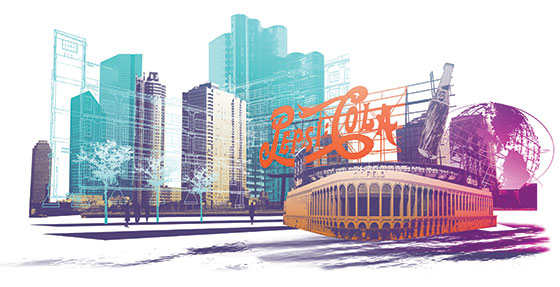
Making New York affordable is, overwhelmingly, a housing issue. Yes, other things are more expensive here than in, say, Wisconsin, but those $5 coffees and $14 cocktails only add up to so much. Whereas the rent here really is too damn high: The median Manhattan home sale last quarter was $872,000, the median income $67,000; in Queens, the numbers are $485,000 and $54,000. Since 1995, Manhattan home prices have more than quadrupled, and median income has risen just 75 percent.
The problem, experts agree, is simply supply—there are a lot more people who want to live here than there are apartments. The solution, therefore, is more building—and even luxury developments help, since added supply of any kind lowers prices throughout the city. New York is gaining something like 75,000 people per year, and we are building only a fifth of the units needed to house them.
De Blasio has called for 200,000 new or preserved units just for the poor and middle class in his first term. That number sounds insanely ambitious, but, given the scope of our needs, also fairly reasonable—more-utopian proposals float even higher goals. No other American city could absorb such a building boom without becoming a radically different place, but it would just make us New Yorkier.
And how to do it—well, that’s where the creative thinking has to come in. The answer is some combination of shaping the market by enabling new supply and mandating that new building accommodate those in need.
Give Queens a skyline.
The lion’s share of affordable New York will be constructed outside Manhattan, because of simple math—there’s more buildable land, and it’s less expensive. Western Queens is the likeliest focus. (Brooklyn, too, but there’s more being built there already.) Vishaan Chakrabarti, the SHoP Architects partner and Columbia University urban-planning maven, puts it this way: “Queens Boulevard, Long Island City—there’s [property] ten, fifteen minutes from Manhattan by subway that still has one- and two-story buildings. Queens, clearly, to me is the future of New York in many ways. I wouldn’t limit it to Queens, though—there are areas in the Bronx that have good subway access, and then St. George on Staten Island.” And those 200,000 units De Blasio wants? “Almost a Co-op City per year. I’ve been on the battlefield—it’s not easy, and it’s a lot of progressive politics rubbing up against each other.” Racism, classism, NIMBYism, ageism, and every other ism will come into play. So will every tool the administration has at hand: tax incentives that tilt the economics toward building at the middle of the income range; subsidies for lower-end building; and rezoning even in the wake of Bloomberg’s rezoning.
Quit making everyone build a garage.
Almost every new residential building, notes the urban-planning strategist Alexander Garvin, is forced by law to include parking. It’s a dated requirement from the early sixties, one that cannibalizes land and makes every building more expensive.
Tax the hell out of vacant lots.
In New York (as in most cities), land and buildings are taxed as one entity, meaning that developers can accumulate land for years, waiting for a booming market to put something up. “Split-rate taxation” taxes the land itself at a higher rate, encouraging developers to build something sooner rather than later.
Do more horse-trading.
Bloomberg’s 80/20 zoning—80 percent of units are market-rate, 20 percent for people of modest income—can be taken further. Chakrabarti and his colleagues are working on 50/30/20 buildings, where the 30 is middle-income. And De Blasio ally Bertha Lewis suggests we could flip the 80/20 ratio entirely.
Lower permit costs.
It costs twice as much to put up a building here as in Chicago. Some of that is the price of land, but a 2005 study by the economists Edward Glaeser and Joseph Gyourko revealed the surprisingly large role played by permit costs. “I’d like to see just a quicker, easier permitting process,” says Glaeser.
Stop wholesale landmarking.
Individual landmarks should surely be preserved; ditto certain blocks or districts that are genuinely of historic value. But when historic districts are widely extended, they significantly reduce the buildable area of the city, argues Glaeser, meaning rents go up everywhere else.
Live at the Javits Center.
No, seriously, says Chakrabarti: “I would look at moving the Javits Center to Sunnyside Yards” and replacing it with apartment buildings as the No. 7 train extension arrives. “It’s a huge opportunity for a new neighborhood.”
Sell off Manhattan’s projects and build bigger, better housing in the boroughs.
It’d be close to politically impossible, but relocating 115,000 NYCHA residents to the outer-boroughs could generate enough money to build several times as many units of affordable and true project housing in less expensive parts of the city. Consider: The housing projects of the Lower East Side are bigger than Stuyvesant Town, which sold for $5.4 billion.
Or make the remaining projects denser.
Many do not take full advantage of their own air rights, and are ringed by parklike plazas. If the city were to sell the rights to build 80/20 housing on those lots, that would bring in cash to build elsewhere (and fix what we have already), as well as introduce ground-floor commercial tenants (good new supermarkets, coffee shops, neighborhood services) missing from existing complexes.
Quit going backward.
We all love to dump on rent control—all of us, that is, who don’t have rent-controlled leases. Yet the number of controlled and stabilized apartments is, in fact, going down. Affordable-housing advocate Shola Olatoye suggests (and works with) programs to offer landlords a good deal: favorable loans to renovate and improve those properties, in return for keeping them affordable for 30 years.
